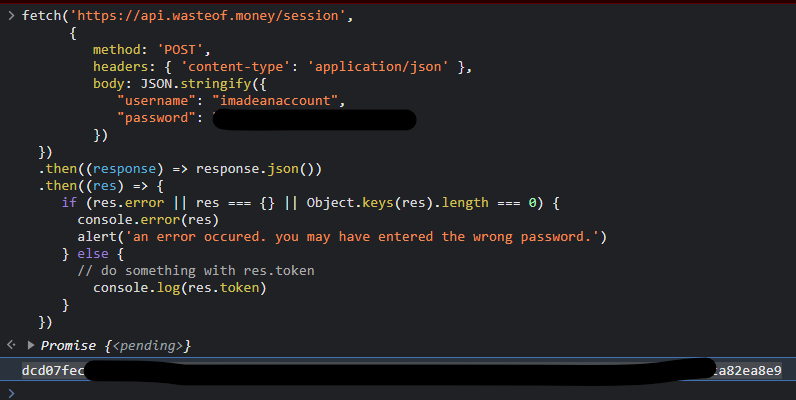@radi8 how do you get a wasteof auth token for use with the API? sorry if this is a dumb question, i’ve never really worked with APIs before
comments
what programming language are you using? if you're using JS (on web), you can do a fetch request using the following code:
fetch('https://api.wasteof.money/session',
{
method: 'POST',
headers: { 'content-type': 'application/json' },
body: JSON.stringify({
"YOUR USERNAME",
"YOUR PASSWORD"
})
})
.then((response) => response.json())
.then((res) => {
if (res.error || res === {} || Object.keys(res).length === 0) {
console.error(res)
alert('an error occured. you may have entered the wrong password.')
} else {
// do something with res.token
}
})This snippet of code accesses the wasteof session API endpoint and gives it a username and password. The API returns an authentication token that can be used for any of the other authenticated endpoints. (getting messages, initiation websockets, etc.)
MDN Web Docs Fetch API reference: https://developer.mozilla.org/en-US/docs/Web/API/Fetch_API/Using_Fetch
Could I define a variable with res.token in } else { ?
don't forget to set the username and password (preferably to a value stored in a .env file if this is some sort of bot). if this is a website then disregard that advice and just use whatever the user’s username/password is. another consideration is that if you run this code on the client of a website, the username/password will be visible to anyone who does Ctrl+Inspect and looks at the Network Tab, so make sure you don't hardcode your username/password or anything.
you can also get session info btw using a GET request to the session endpoint to get details about the logged-in session (i don't know if this is important for your purposes)
fetch('https://api.wasteof.money/session',
{
method: 'GET',
headers: { 'content-type': 'application/json', 'Authorization': "YOUR RES.TOKEN HERE" },
})
.then((response) => response.json())
.then((res) => {
if (res.error || res === {} || Object.keys(res).length === 0) {
console.error(res)
alert('an error occured. you may have entered the wrong password.')
} else {
// do something with res
}
})which returns an object like:
{
"user": {
"name": "imadeanaccount",
"id": "63fcf11ebac4b7a8034e1327",
"bio": "Beta user, developer who made an account | :D | Follow to see more of my posts.  ",
"verified": false,
"permissions": {
"admin": false,
"banned": false
},
"beta": true,
"color": "yellow",
"links": [],
"history": {
"joined": 1677521182357
}
},
"flags": {
"isAdminImpersonating": false,
"showRecoveryMessage": false
}
}
",
"verified": false,
"permissions": {
"admin": false,
"banned": false
},
"beta": true,
"color": "yellow",
"links": [],
"history": {
"joined": 1677521182357
}
},
"flags": {
"isAdminImpersonating": false,
"showRecoveryMessage": false
}
}if you are creating a client website or something this might be useful.
SyntaxError: Unexpected string (at fetch.js:10:13)
This is happening at:
body: JSON.stringify({
"YOUR USERNAME", ← here, stringify does not seem to be working
oh sorry! i made a mistake, this section shold be:
body: JSON.stringify({
"username": "YOUR USERNAME",
"password": "YOUR PASSWORD"
})Well now it’s not doing anything :P
I’m having the console log res.token but it’s not logging anything
what type of site are you making? can you try pasting your code into the JS console of a wasteof tab cause it’s working for me there:
